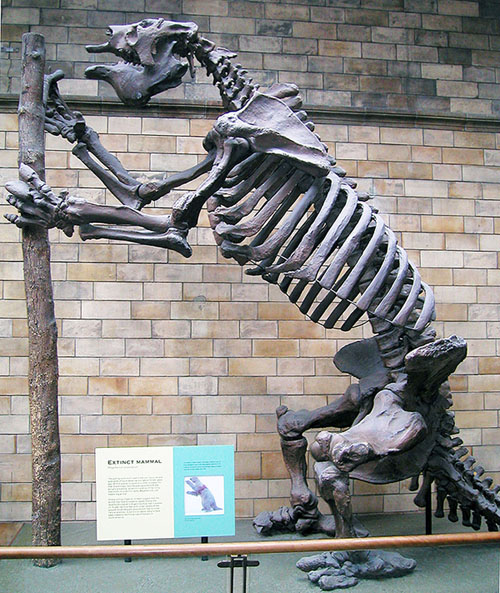Megalonyx
Today, Jefferson meets Great Claw. The University of Houston's College of Engineering presents this series about the machines that make our civilization run, and the people whose ingenuity created them.
I've noticed, but only in passing, a skeleton that often turns up in natural science museums. He's roughly the size of an elephant. He's usually posed on his squat hind legs, with his massive paws clawing at a tree. This huge plant-eating tree sloth was first identified by Thomas Jefferson in 1797. Jefferson called him megalonyx, which means great claw.
Jefferson had been arguing with the famed French naturalist Buffon. Buffon claimed that animal and human dwellers of the Western Hemisphere were smaller and fewer than those on his side of the sea. Jefferson did not take that lying down. Megalonyx would later provide the crowning piece of evidence he needed.
But previously, in 1786, Jefferson's book, Notes on the State of Virginia, was published in Paris. In that record of American flora, fauna, demographics, and geography, Jefferson emphasized the great size of many American animals. The Notes came out the same year Jefferson became America's new Ambassador to France.
Naturally, Buffon expressed interest in Jefferson's claims, so Jefferson wrote to the governor of New Hampshire. He asked for, "the skin, the skeleton, and the horns of the Moose, the Caribou, or Elk ... but most especially those of the Moose." A year later, the remains of a moose, seven feet tall at its shoulder, arrived and Jefferson presented it to Buffon. Buffon thanked him and promised to mount it for the King. He also said that he'd correct his claims about size. (The movie Jefferson in Paris shows Jefferson presenting the mounted moose. Actually, he never did see the creature mounted, and Buffon died before he could correct anything.)
Now Jefferson is back home and he's been given bones from this huge tree sloth. They'd been found in a limestone cave in the Blue Mountains. His careful analysis of the few bones suggested a creature seven feet tall and weighing a ton, although he was unsure of it's exact form. Maybe it was kin to a rhinoceros. He presented those findings to the American Philosophical Society -- challenging Buffon's notions that creatures of different sizes arose in different portions of the globe.
But, evidence of larger creatures here, he said, did not mean we could "shut our eyes upon on half [the] facts, and build systems on the other half." Creatures of all sizes may be found all over.
Seven years later, when Jefferson sent Lewis and Clark to explore America, he asked them to find a living megalonyx. That may seem odd, but in his paper he'd written: "The animal species which has once been put into a train of motion, is still probably moving in that train." Well, despite Jefferson, species do die out.
Still, we aren't sure when megalonyx disappeared. Some may've still lived in the Caribbean a few hundred years before Jefferson's birth. And maybe Jefferson himself is an extinct species -- less a president dabbling in science than a very well-informed scientist who happened to have a special interest in government.
I'm John Lienhard, at the University of Houston, where we're interested in the way inventive minds work.
S. A. Bedini, Jefferson, Thomas. Dictionary of Scientific Biography, C. C. Gillispie, ed., Vol. 7 (New York: Charles Scribner's Sons, 1972): pp. 88-90.
T. Jefferson, A Memoir on the Discovery of Certain Bones of a Quadruped of the Clawed Kind in the Western Parts of Virginia. Transactions of the American Philosophical Society, Vol. a 1799, pp. 246-260. (Jefferson read this paper to the Society two years earlier, in 1797.)
The megalonyx jeffersoni below is identified by its broader classification, megatherium, in the London Museum. (Photo by JHL)

The following illustration is from H. W. Shimer, An Introduction the Study of Fossils (Plants and Animals). (New York The Macmillan Company, 1914.): pg. 383. It reflects Jefferson's view, in that it presents (for the most part) larger North American animals of the Ice Age. It claims the beasts are represented in their true relative scale, although the megalonyx, No. 2, might actually be a bit smaller than they actually grew, and the beaver, No. 5, significantly larger.